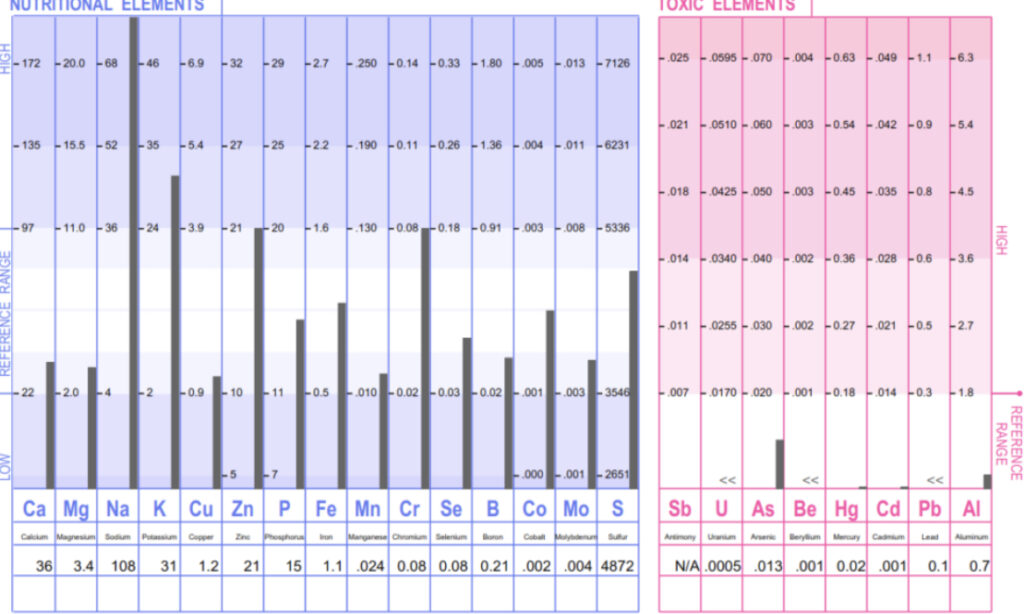What is HTMA?
Hair Tissue Mineral Analysis (HTMA) is a soft tissue mineral biopsy that provides a reading of the mineral deposition in the cells and interstitial spaces of the hair over a 2-3 month period. HTMA is only representative of the minerals and heavy metals in the hair, but since hair is a tissue, the information can be inferred for the rest of the body. HTMA is a SCREENING test, NOT a diagnostic test. We are looking at a deeper level, we are looking at the underlying imbalances. By correcting those imbalances we can clear out multiple health issues at the same time. HTMA is representative of an average rate of mineral and heavy metal accumulation in the hair sample over the previous 8-12 weeks. Today, hair analysis or more formally HTMA is used globally by various institutions, agencies, healthcare professionals, universities, and practitioners in Complementary and Alternative Medicine.

What is the HTMA lab procedure?
Trace Elements and Analytical Research Labs are two licensed and certified clinical laboratories that undergo regular inspections with the Clinical Laboratory Division of the Department of Health and Human Services, HCFA. They use ICP-Mass Spectrometry, the most modern and expensive analytical technique to be applied to routine elemental analysis. These two labs do not wash hair samples.
Why hair?
Hair is ideal tissue for sampling and testing. It is painless and easy to collect the sample and can be sent to the lab without special handling requirements. Hair is formed from clusters of specialized cells that make up the hair follicle. During the growth phase, the hair is exposed to the internal environment, such as blood, lymph, and extra-cellular fluids. As the hair continues to grow and reaches the skin’s surface, its outer layers harden, locking in the metabolic products accumulated during the formation period. This biological process provides a blueprint and lasting record of mineral status and nutritional and metabolic activity during this time. A hair tissue mineral analysis reveals a unique metabolic world: intracellular activity, which cannot be seen through most of other tests. Mineral levels in the hair are about 10x that of the blood. It is cost effective, accurate and reliable.
What can you learn from HTMA?
- Metabolic rate
- Stage of stress and stress level
- Immune system
- Adrenal and Thyroid glandular activity
- Carbohydrate tolerance
- Energy levels
- Eating enough protein or too much carbs
- Tendencies for 30+ illnesses often before they manifest
- Personality tendencies
What can NOT be learned from HTMA?
- The total body load of any single mineral level
- The diagnosis of any illness or disease
- A “prescription” for specific supplements
What are the benefits of HTMA testing?
When we balance minerals often things like hormones, fatigue, brain fog, digestive issues, etc. get fixed. Knowing your mineral levels can tell us about heaps of stuff going on in your body. Some of the things we can look into are:
- How effectively your body is making energy
- How well you are managing stress
- Your energy levels and fatigue
- Adrenal and Thyroid activity
- Liver and kidney stress
- Why you keep getting sick
- How well are you digesting your food
- Nutritional defficiencies
- Your glucose metabolism and blood sugar
- Your heavy metals toxicity status
- We can even discover some personality tendencies
Why can’t I just do blood test to look at my mineral system?
Blood testing is excellent in many ways, but it is not optimal for mineral and heavy metal levels. Blood is a transport medium that is outside of our cells. Mineral levels are kept relatively constant in the blood due to the blood desire for homeostasis ( stable internal environment ). Blood mineral levels are generally maintained at the expense of the tissues and minerals will be robbed from the tissues to maintain the blood. Do not try to compare hair tests and blood tests side by side because they each represent a different homeostatic system and different body compartments. Each testing modality has pros and cons and one is not more valid than the other. I recommend using both when possible. Using HTMA and blood together provides two different pieces of the puzzle and provide a more complete picture of what’s happening in the body. Blood analysis for minerals is a good indicator of transport of minerals to and from storage areas of the body outside the cells. HTMA is a good indicator of the metabolic processes occurring within the cells. Toxic metals are not found in high concentration in the blood except after acute exposure. This makes it difficult to test for low levels of chronic exposure and accumulation over time. Toxic metals concentrate in soft tissues ( hair ), not blood.
Why test for minerals?
Minerals are essential in countless metabolic functions in all phases of life process. In the words of the late author and researcher, Dr. Henry Schroeder minerals are “…more important factors in human nutrition than vitamins. The body can manufacture many vitamins, but it cannot produce necessary minerals or get rid of many possible excesses.”
What can cause mineral imbalance?
There are many factors to take into consideration, such as: diet, stress, medications, pollution, nutritional supplements, and inherited patterns.
Can anybody read HTMA test?
No! It is incredibly important that you get a practitioner well versed in interpreting HTMA results. I can’t stress this enough! It is not as simple as minerals just being in or out of set ranges. Each mineral must be assessed against other minerals on the panel as well as with the presenting conditions of the client. A comprehensive understanding is vital if the HTMA is to be interpreted correctly. For example, we don’t correct low mineral levels by taking more of or eating more of that mineral. It’s more complicated than that. Low mineral levels on the HTMA may not indicate a deficiency necessarily, it may be a problem with the metabolism of that mineral or missing synergistic factor. Don’t try to interpret the HTMA results on your own and take unnecessary supplements that can exacerbate the imbalances or deficiencies.
Is hair tissue mineral analysis supported by research?
Hair tissue mineral analysis is supported by an impressive body of literature in a variety of respected national and international scientific publications. Each year in the United States alone, federally licensed clinical laboratories perform over 150,000 hair mineral assays for health care professionals interested in an additional screening aid for a comprehensive patient evaluation.

